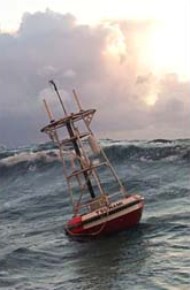|
|
|
QUICK
LINKS |
|
-- Sea Morphology
Changes and Sensor Placement
|
|
-- Team 5 Home -- Mission 2009 -- MIT |
|
|
Tsunami Prediction Algorithms
As with
any examination of naturally occurring events, the number of
confounding
variables associated with any isolated even is almost incomprehensible;
however, some sense can be made of Tsunamis as algorithmic events if
the right
variables are examined.
Currently, mathematical models are
mainly used post-tsunami. These models
can be utilized to model the events that occurred during a given time
period,
generally beginning with an earthquake or other seismic event and
ending with
the dissipation of the tsunami waves.
For example, scientists were able to model both the 1755 and
1969
tsunami events that affected the western coasts of
Ideally, however, mathematical
models
could be used to determine magnitudes and directions of tsunamis, as
well as
predict which area(s) along a given coast are at the highest risk
during a
given tsunami. One example of a tsunami
risk assessment model was developed for the coast of
The arrival time of the tsunami can be
determined for each section of the coast, which allows us to assess the
risk
for each area based on the time of arrival.
In the Japanese case, all the times were approximately twenty
minutes,
meaning that there exists almost no disparity between risk assessments
for each
area; however, if the model were applied on a larger scale (for
example, on the
coast of Peru), the disparities calculated for sections of the coast
would
allow risk factors to be determined and to allow for communications to
those
areas to be prioritized.
The “ratio of excess” can be determined
by the total number of historical tsunamis and the arrival of tsunami
waves
over three meters tall at specific locations.
We can determine the probability of waves being over five meters
tall in
each area. As with the arrival time, the
disparities calculated based on the ratio of excess can be used to
determine
which areas are at greater risk [2].
The determination of risk acquired from
the arrival time and the ratio of excess can also be applied to the
placement
of the sensor system. If we know areas
that are at a greater risk level, we can place the sensors closer to
said areas
so that those areas will be warned about an event more quickly than
they
otherwise would [2].
These models can be developed,
theoretically, based on data collected by the DART II system or a
similar
sensor system. In real time, data could
be collected by various sensor points and instantaneously be used to
estimate
arrival time and, combined with a predetermined ratio of excess, to
determine
which areas should be evacuated or warned.
As aforementioned, the examination of
natural events can be a seemingly impossible task, and by no means is
it a
simple one. I have taken a step towards
understanding existing models, allowing for more informed decisions
concerning
sensor systems for earthquakes and tsunamis to supplement current
algorithms
and future mathematical tsunami models.
Note:
Bibliography
[1] Mendes,
V.L., Baptista, M.A., Miranda, J.M., Miranda,
P.M.A. (1999). Can
Hydrodynamic Modeling of Tsunami Contribute to Seismic Risk Assessment?
Physics and Chemistry of the Earth Part
A: Solid Earth and Geodesy, 24,
139-144.
[2]
Sato, Hiroaki., Murakami, Hitoshi., Kozuki,
Yasunori.,
Yamamoto, Naoaki. (2003).
Study On Simplified Method of Tsunami
Risk Assessment. Natural
Hazards, 29,
325-340.
Page
last updated by cwhit at 11/02/2005 8:41:32 P.M.

